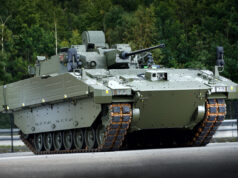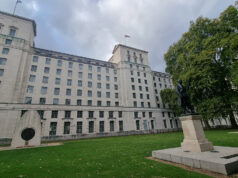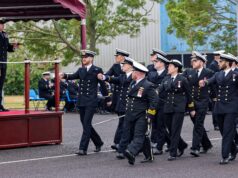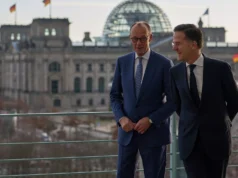RBSL announced that welding is complete on the first UK manufactured mission module for the Boxer MIV Programme. It will now move into paint and assembly for the next stage of the manufacturing process.
Brian Fisher, MIV Production Manager said this milestone marks “significant progress” for the programme.
He added: “The first and second Mission Modules have progressed through the welding assembly stations and we are delighted to announce that welding on vehicle one is now complete.
“The MIV team have worked diligently and performed really well to get us to this position and our team of welders are continuing to gain knowledge and experience daily, whilst highlighting improvements within the manufacturing process. This is significant progress and we are moving closer each day to Boxer rolling off the production lines at Telford.”
The Boxer programme will deliver more than 600 vehicles to the British Army. Production has been subcontracted equally between RBSL and Stockport-based KNDS. Both companies are undertaking fabrication of the armoured vehicle structures together with assembly, integration and testing of the complete vehicles at their respective facilities. Work to fabricate key components of the programme officially started on March 27 at RBSL’s manufacturing facility in Telford.
Speaking at the time, Colin McClean, RBSL Managing Director said: “RBSL is proud to be regenerating this armoured vehicle capability and contributing to the Land Industrial Strategy, marking a new chapter in vehicle manufacture for the UK defence industry. Not only will the delivery of Boxer provide the British Army with a complete step-change in capability to meet their MIV requirement, it will also protect vital engineering and manufacturing skills as a sovereign capability to the UK and we are incredibly proud to be a part of this milestone, alongside our partners in KNDS.”
RBSL is playing a key part in delivering the Land Industrial Strategy through the Boxer programme, as well as through its Challenger and In-Service Support contracts. The multi-million pound investment in its Telford facility, and the creation of jobs within RBSL and the UK supply chain, contributes towards national industrial resilience, and the social value and ‘levelling up’ aspirations the UK Government has set out.
RBSL’s Industrialisation Programme is also now complete, with all MIV Production facilities installed and commissioned. The business has invested £40m in its 29-acre site, transforming it into a world-class manufacturing facility so that it can deliver next generation military vehicles and essential in-service support.
All parts for Boxer have been sourced through RBSL’s robust supply chain and the business is in the process of finalising orders with its suppliers in line with the Boxer production schedule.
RBSL is continuing to work alongside Defence Equipment and Support (DE&S) to continue to deliver the MIV Programme at pace. It will now begin progressing sub-assembly items into vehicle one, including the bulkhead, wheel hubs and drivers hatch, with the first power pack being assembled and tested thereafter. When the Drive Module and Mission Module are fully equipped they will then be integrated together ready for commissioning and testing at the end of the year.














Excellent. lets keep the colour scheme too
So you think they are going for racetrack? 😃😀
Do we not get to hear which type of mission module? What will the first UK Boxer be?
Probably a kitchen version… /sc
Hopefully an IFV Mission Module with a stabilised 40mm cannon. (Apologies, just got to ‘crowbar’ that in!]
Plus a couple of ATM’s!!! 😁
We can but hope Graham…..
APC, C2 Command Vehicles, and Ambulances variants have been ordered so far, but no IFVs.
Evidence that British Army have lots of money.
Yes, the Boxer is about the most expensive wheeled APC in the world…and the order has to increase substantially above the 623 ordered so far, as not enough section carriers have yet been ordered for the five AI Bns.
Thanks mate. My comment was tongue-in-cheek, really – the army is now in its 5th month of contemplating how to bring greater lethality to bear from a Boxer vehicle.
The Tranche 1 order (Qty 523) also included 50 repair/recovery variants.
The Tr2 order of 100 vehicles has not so far been broken down, surprisingly.
As far as I can find it still looks like the MOD has indicated it will be 12.5mm machine gun in an automatic turret…which is disappointing and a problem as it’s been shown to be ineffective in Ukraine….There is a design that’s been shown at DSEI for a UK manufacturing automatic turret with a 30mm cannon, spike anti tank missiles and trophy active defence system,,,,,,this would make the
Upgraded Warrior would of course have delivered a stabilised 40mm cannon.
Yes I’m not sure why they did not go with the warrior upgrade TBH. Good hulls and they had already purchased the guns if I remember rightly.
Concise & clear….?
A giant BV module
Mr McClean correctly says that Boxer is filling the MIV requirement, which Boxer was always intended to do. That was originally to replace Saxon, FV430s (those that remained in service after the Warrior programme delivered) and non-recce CVR(T). [Arguably Saxon was replaced by PM vehs that were taken into core after Op Telic/Herrick ended].
Since March 2021 HMG has decided that Boxer can and will now also replace the in-service Warrior IFV, rather than WCSP to meet the AI remit – we shall see!
Need a lot more than 623 Boxers to meet both the MIV and AI remit of course.
I should have added that we left the original Boxer programme to pursue FRES. FRES SV evolved into Ajax and FRES utility sort of migrated to MIV. Perhaps there has been confusion now over whether non-recce CVR(T)s are being replaced by Ajax variants or Boxer variants – or both?
You forgot to mention the original Tracer programme, which has two competitors working jointly with US, but they went down the Stryker route. That program was running in Chertsey in the late 90’s. MRAV was originally going to be a mix of Wheeled and Tracked variants. The. FRES came about at the beginning of the century, with if I recall correctly about 8 variants and was all tracked. They were going to replace the FV430’s and Saxons, and I remember asking what was then DLO, what about the Saxon’s in Cyprus. Blank looks as they hadn’t taken them into account.
Hi Mark, I purposefully did not mention TRACER as that was for a recce vehicle to replace Scimitar, rather than a MRAV, ABSV or MIV, which is what this article is about.
I had mixed feelings about TRACER as we do recce by stealth in small, fast & agile, quiet(ish) vehicles – and the Yanks had M3 Bradley CFV doing recce by fighting. Totally different philosophies. It seems we have moved some way down the American route – it will be hard to be that stealthy in an Ajax!
I had forgotten about Saxons in Cyprus! We had three bns of them in 24 Inf Bde in the 80s.
Bit of both I think. It is still up in the air a bit.
I think Ajax variants will overwhelmingly be in the RAC Armoured Cav Regs, with others in the Armoured Regs, the 2 RA Regs supporting 12 and 20, and assume Ajax Scout is still in the Mech Bns Recc Pltns that replace Warrior and the Armd Regs Recc Troops.
Assume also in the 2 supporting REME Bns too.
Boxer mostly to the infantry, with others in RA, RS, REME, RAMC, and RE formations.
Before, with 2 AI Bdes and 2 Strike Bdes, there was a clearer demarcation. Now, with the two effectively merged, there seem to be too many c2 Boxer variants for the units that need them vs Infantry carriers.
Yes, thats the way I see Ajax and Boxer being allocated – ie standard distribution. Perhaps I was tainted by bean counters to mention possible duplication of Boxer and Ajax specialist variants.
I wonder why there has been no published breakdown of the 100 Boxers in Tr2? Very strange.
As we mentioned a while back there were very few Inf Carriers in Tr1 – only 85? Perhaps Tr2 is all Section Carriers? That 185 would be enough Sction Carriers for the 5 AI Bns.
Yes, it was 80 something. There are several turrets on show at DSEI apparently ideal for Boxer. Hope one is chosen soon to put us out of our misery.
A very expensive choice to choose a Boxer for that.
No we don’t Graham, remember the tail wags the dog, so you shrink the Army to match 623 Boxers, job done 👍
RBSL is of course a JV comprising Rheinmetall and BAE.
Less well known is that KNDS is a JV comprising Krauss-Maffei Wegmann and Nexter.
Bit sad we can’t now build wheeled APCs without a lot of help from the French and the Germans!
First 117 British Boxers built on German production lines
Embarrassing (that we had to recreate our own AFV manufacturing capability from scratch and this took time) but if it gets 117 new wagons into the hands of the British Army faster then…fair play.
Imagine if we let the naval ship and submarine-building industry or the military aircraft-building industry die out – there would be questions in the House at the very least!
As we were only discussing the other day mate, we let our military small arms capability die out in the mid 90’s and no one even noticed….
Good news. Shame foreign aid money isn’t being used to triple production and donate to Ukraine. I always thought it made sense to use Aid money to increase existing production lines.
Would be nice to see some of the Aussie style IFV variants or maybe even the MGS Boxer. Not going to happen but, would be nice if it did.
The good thing about boxer is the base vehicle can mount any module that is available.
Main thing is just get the most amount of base vehicles into service then modules can be added when funds are available. The army should really still try to get a tracked IFV even just 200. Then boxer IFV variants can be sought.
With the cost of each boxer and the limited budget available it’s going to be a difficult task to get what’s needed.
That’s excellent the Boxer’s are quite good really, how many more will be produced by the end of the year?🤔
I have read they are looking at 60 a year between the 2 sites once it ramps up.
Will be some years equip the army.
Once production is ramped up to 60/year, it will take 10 years to deliver Tr1 and Tr2…then there just has to be a Tr3.
I know. Would it be worth continuing production in Germany too? Just to get the vehicles sooner?
I think thats a great idea.
I think so. I don’t care for complaints that it is keeping other nations workers employed! We needed the vehicles a decade ago, or more.
Germany was looking at procuring Boxers from the Australian production line (100 units). That, apparently, may have stalled. If that is the case, then the German production line may be more than a little busy.
Genuine enquiry: ‘Manufactured’ (in U.K.) or assembled?
I am a bit confused with Boxer or should I say the way it is getting built. That we have two sites for the production of the main body I understand, but should we not have three or four sites to build modules. Is it not the module that gives Boxer its role.
So for 600 drive units we might have 1800-2500 modules. The modules themselves comes in three or four main groupings carrying, electronics, weapons and engineering. Carrying means basically a box for troops, casualties, cargo etc. Electronics, would be command and control, radar, communications,EW etc. Weapons could be turreted weapons such as the 30mm, 35mm, 40mm, 105mm, 155mm and heavy mortars or they could be missile carrying modules could be with the anti tank Brimstone or in the air defence with Starstrak or even CAAM. I am not sure if a MLRS version could be built but I see no reason why not. Then comes the Engineering modules, these could be anything from recovery to bridge laying including mine clearance.
So you could see why I am confused, if we have two locations producing the Boxer it looks to me as if the concept of using modules to adapt the drive module to the need is out of the window. We as I said could have further locations producing modules, Each location would build, design and develop modules in each of the four main groupings. Who knows but if we get this right we could then develop the idea further for RFA and OPV operations.
The various reports are confusing, particularly those from RBSL, which I believe are spun too heavily. I had thought the two production lines were for base hulls and modules, WFEL building the bases and RBSL building the modules. Now I’m not so sure. What I think is happening is that WFEL build most of the drive units (480) and RBSL and WFEL split the mission module production between them, with RBSL getting more of the modules. I believe the modules are assembled along with the bases and are not delievered separately. So there will be no surfeit of mission modules.
From an excellent article from Battlespace, regarding work at Telford. (I won’t link as I find links get my posts sent to arbitration purgatory – you’ll have to Google)
“… the Mission Module is fabricated in Hall 2.The Drive Modules from WFEL in Stockport come into the plant at the other end and are mated to the Mission Module in Hall 3.”
Seems pretty clear. It also says
“RBSL and WFEL are responsible for the Infantry Carrier and Command Vehicles whilst WFEL will build the 50 specialist Ambulance variants”
which implies both sites do mission modules.
Then there’s an article from RBSL that talks about power pack deliveries
“[David Brown Santasalo will] integrate the [Rolls Royce] engines into the complete Boxer Powerpack Assemblies, prior to delivery to WFEL.
Again implying drive modules are only assembled at WFEL.”
However other sites (such as the Engineer) report
“For RBSL, assembly and testing of the Boxer Powerpack (transmission, engine and cooling systems) will take place at its manufacturing site in Telford.”
So that’s as clear as mud, right? Do WFEL do all the drive modules or not? That’s why I think it’s most.
Shephard say
“[WFEL/KNDS(UK)] will manufacture approximately 480 Boxer drive modules and assemble fewer than half of them into APC, Ambulance and SCV variants. The rest of the WFEL-manufactured drive modules will be shipped to RBSL for final assembly.”
And don’t forget the first hundred or so are being built in Germany (105 or 117 depending on which website reports). I hope that helps, because trying to figure out how many of what type is to be assembled where and when, should be easier to figure out than this.
https://www.tanknology.co.uk/post/boxer-modularity
This site covers it in detail with pictures and Youtube of modules and base being separated/joined
This disadvantage its a really big beast and up to 38 tonnes
https://static.wixstatic.com/media/d90363_a0ed6d13c354446b934399e02eb3d58b~mv2.png
It is why I doubt the army would want to deploy overseas on tour with a lot of ‘spare’ modules.
Just to add, when RBSL say the work is split evenly, I’m pretty sure they mean a 50/50 financial split.
If most of these reports can be pieced together correctly of the 623 total,
117 drive units are built in Germany.
480 drive units are built in Stockport
27 drive units are built in Telford.
I wouldn’t bet the farm on these numbers though. I’m havng a hard time figuring why Telford might be building those few drive units.
I really could not see that we would have 3 or 4 times as many modules as base vehicles. I could not see the army wanting to deploy overseas with a lot of spare modules that would have to be transported specially, then stored.
I could see the army configuring the vehicles to the upcoming mission in the UK fitting base vehicles with the ‘best guess’ module and deploying additionally with only a few ‘loose’ modules.
We have ordered 50 or more repair/recovery modules that are being built specially for the UK market – other countries have seperate repair and recovery modules.
Not sure why having two companies each in a dfiferent location producing base vehicles means that the modular concept has been abandoned?
Electric…….?’